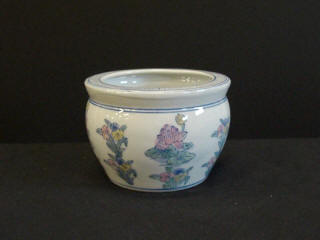Search
Related Articles
- The Art of Chinese Pottery and Porcelain
- The Art of Chinese Chop Engraving
- Ancient Chinese Jewelry
- Chinese Handicrafts
Sponsor Ad
Chinese Culture >> Oriental Pottery
The History of Oriental Pottery
The history of Oriental pottery-making, for the most part, is much like that of the rest of the world. Improvements were made gradually over thousands of years, although the Japanese and Chinese apparently got a head-start in the field.
As early as 3000 B.C., Chinese ceramists were shaping some of the most artistic Oriental pottery in the annals of man, Europe at this date was still the home of roving bands of barbarians, who knew little more about making pottery than their earliest forebears.
Probably the most august age of Chinese ceramics was during the Sung Dynasty, which lasted from 960-1279 A.D. It was in this period that porcelain was first developed. The earliest known examples of porcelain are of the ying Ch'ing type a soft-looking, bubbly glaze, white in color but with a faint tinge of iridescent green or blue.

Chinese artisans jealously guarded their individual techniques for producing porcelain. The clay had to be properly aged, in many cases for centuries. Succeeding generations of potters inherited the family's supply of clay, which was buried in the ground to be dug up more than 100 years later by a potter's son or grandson. When Oriental porcelain was introduced into Europe in the 15th century, it made even the most beautiful of western pottery look shabby by comparison. European ceramists regarded the Chinese and later, Japanese wares with awe and envy. Ambitious efforts were made to imitate the imported porcelain, which was in heavy demand among wealthy collectors. When Italian potters took to coating their earthenware with white enamel, which gave a superficial porcelain look, it was only the first of a long list of dismal failures.
The problem soon attracted the attention of Italian majolists and alchemists. The first reasonable imitation of porcelain was made at Florence in 1585 by a team of alchemists and potters working under the patronage of Francesco de Medici.
This Florentine "porcelain" was the forerunner of many European wares made in avowed imitation of true Oriental porcelain. They form a link between pottery and glass, for they may be considered either as pottery rendered translucent or as glass rendered opaque by shaping and firing a mixture containing a large percentage of glass with small amounts of clay.
But the search for the secret of true porcelain manufacture was excitedly continued by European ceramists for generations. The imitations ran the gamut of invention and ingenuity. By the mid-17th century, the research was considered so important that the experimenters, backed by such patrons as the Elector of Saxony and Madame de Pompadour, were more interested in solving the riddle of porcelain than they were in the transmutation of base metals into gold.
About the Author:
Mitch Johnson is a regular writer for http://www.curtains-n-drapes.com/ , http://www.hubforceramics.info/ , http://www.goodbudgetholiday.info/
